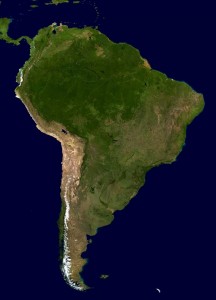South America
 South America, fourth largest of the world’s continents. It is the southern portion of the landmass generally referred to as the New World, the Western Hemisphere, or simply the Americas. The continent is compact and roughly triangular in shape, being broad in the north and tapering to a point—Cape Horn, Chile—in the south.
South America, fourth largest of the world’s continents. It is the southern portion of the landmass generally referred to as the New World, the Western Hemisphere, or simply the Americas. The continent is compact and roughly triangular in shape, being broad in the north and tapering to a point—Cape Horn, Chile—in the south.
South America is bounded by the Caribbean Sea to the northwest and north, the Atlantic Ocean to the northeast, east, and southeast, and the Pacific Ocean to the west. In the northwest it is joined to North America by the Isthmus of Panama, a land bridge narrowing to about 50 miles (80 km) at one point. Drake Passage, south of Cape Horn, separates South America from Antarctica.
Relatively few islands rim the continent, except in the south. These include the glaciated coastal archipelagoes of Argentina and Chile. The Falkland (Malvinas) Islands are east of southern Argentina. To the north, the West Indies stretch from Trinidad to Florida, but those islands usually are associated with North America. Of the remainder, most are small oceanic islands off the coasts of South America, including the Galapagos Islands, Ecuador, in the Pacific Ocean.
South America has a total area of about 6,878,000 square miles (17,814,000 square km), or roughly one-eighth of the land surface of Earth. Its greatest north-south extent is about 4,700 miles, from Point Gallinas, Colombia, to Cape Horn, while its greatest east-west extent is some 3,300 miles, from Cape Branco, Brazil, to Point Pariñas, Peru. At 22,831 feet (6,959 metres) above sea level, Mount Aconcagua, in Argentina, near the border with Chile, is not only the continent’s highest point but also the highest elevation in the Western Hemisphere. The Valdés Peninsula, on the southeastern coast of Argentina, includes the lowest point, at 131 feet (40 metres) below sea level. In relation to its area, the continent’s coastline—some 15,800 miles in length—is exceptionally short.
The name America is derived from that of the Italian navigator Amerigo Vespucci, one of the earliest European explorers of the New World. The term America originally was applied only to South America, but the designation soon was applied to the entire landmass. Because Mexico and Central Americabshare an Iberian heritage with nearly all of South America, this entire region frequently is grouped under the name Latin America.
South America’s geologic structure consists of two dissymmetric parts. In the larger, eastern portion are found a number of stable shields forming highland regions, separated by large basins (including the vast Amazon basin). The western portion is occupied almost entirely by the Andes Mountains. The Andes—formed as the South American Plate drifted westward and forced the oceanic plate to the west under it—constitute a gigantic backbone along the entire Pacific coast of the continent. The basins east of the Andes and between the eastern highlands have been filled with large quantities of sediment washed down by the continent’s great rivers and their tributaries.
No other continent—except Antarctica—penetrates so far to the south. Although the northern part of South America extends north of the Equator and four-fifths of its landmass is located within the tropics, it also reaches subantarctic latitudes. Much of the high Andes lie within the tropics but include extensive zones of temperate or cold climate in the vicinity of the Equator—a circumstance that is unique. The great range in elevation produces an unrivaled diversity of climatic and ecological zones, which is probably the most prominent characteristic of South American geography.
The original inhabitants of South America are believed to have descended from the same Asiatic peoples who migrated to North America from Siberia during the most recent (Wisconsin) ice age. Few of these peoples, however, survived the arrival of Europeans after 1500, most succumbing to disease or mixing with people of European and (especially in Brazil) African origin. Some parts of the continent are now industrialized, with modern cities, but the people in rural areas still follow an agricultural way of life. The wealth of mineral products and renewable resources is considerable, yet economic development in most of the continent lags behind the more industrially advanced regions of the world. Nonetheless, concern has arisen about the rapidly increasing and often destructive exploitation of these resources.



